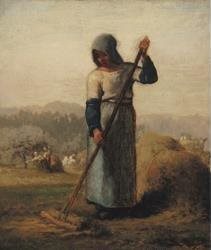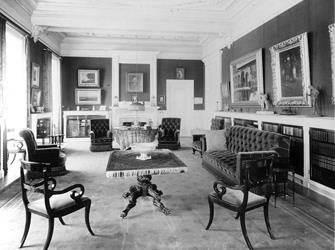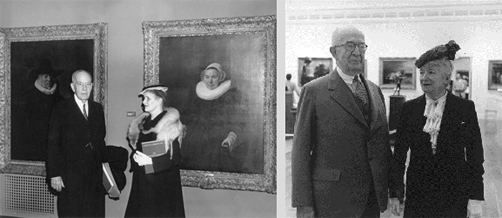
JUNE 4–SEPTEMBER 4, 2006
the Clark Brothers: An Introduction
Jean-Léon Gérôme
Pollice Verso (Thumbs Down), 1872
Oil on canvas
Collection of Phoenix Art Museum. Museum Purchase
Alfred Clark bought this painting in the 1880s, when Gérôme's work was very popular with American collectors. In his diaries Sterling recalls admiring the painting when it hung alongside Gérôme's Snake Charmer in his parents' house. It was bequeathed to him at his mother's death in 1909, but he soon traded it for another painting.
Jean-François Millet
Woman with a Rake, c. 1856–57
Oil on canvas
The Metropolitan Museum of Art, New York. Gift of Stephen C. Clark, 1938
This painting was acquired by Alfred Clark, the father of Sterling and Stephen, in 1889, and passed down through the family to Stephen. Alfred's taste for Millet was typical of wealthy American collectors of the late nineteenth century, and this small painting of women working in the fields is characteristic of the artist's interest in peasant life.
Jean-Léon Gérôme
The Snake Charmer, c. 1879
Oil on canvas
Sterling and Francine Clark Art Institute, Williamstown, Massachusetts
In his diaries Sterling recalls admiring this painting when it hung alongside Gérôme's Pollice Verso in his parents' home, noting that "both were celebrated in their day." Although his mother sold The Snake Charmer in 1899, Sterling managed to buy it for himself in 1942, and regarded it as a "masterpiece." Gérôme's fastidious attention to detail appealed to Sterling's taste for finely painted pictures.
The living room of Elizabeth Scriven Clark's house on Riverside Drive in New York City, c. 1898–99. Elizabeth, like her husband Alfred, was an active art collector, teaching her sons Sterling and Stephen to understand and appreciate art.
Opening day at the National Baseball Hall of Fame and Museum, 1939. Stephen Clark founded the Hall of Fame and served as its president until his death.
Photo courtesy of Fenimore Art Museum, Cooperstown, New York.
The Sterling and Francine Clark Art Institute opened to the public in May 1955, to display the Clarks' collection of works ranging from Italian Renaissance to Impressionist masters.
Left: Stephen and Susan Clark at the Yale University Art Gallery, 1956
Right: Sterling and Francine Clark at the opening of the Clark, May 1955
Stephen founded the Fenimore Art Museum and the Farmers' Museum, along with the Baseball Hall of Fame, in Cooperstown, and he was a trustee of the Metropolitan Museum of Art and the Museum of Modern Art in New York. He bequeathed most of his art collection at his death to the Metropolitan Museum, the Yale University Art Gallery, where he had attended college, and the Fenimore Art Museum.
Sterling, who had lived in Paris and New York and had considered preserving his collection in both cities, chose to establish a museum in Williamstown, near the college his grandfather had attended. He founded a research and academic institute and library as well as an art museum, and each of these is now among the country's foremost institutions of its kind.
Sterling and Stephen Clark grew up in a family in which art played a vital role. The family was based in New York City and Cooperstown, New York, where Edward Clark acquired a plot of land in 1856 on which he would build the Clark family home. Edward later bequeathed the property and wealth he had acquired as head of the Singer Sewing Machine Company to his son, Alfred, and his four grandsons, Edward, Sterling, Ambrose, and Stephen. Both Alfred and his wife Elizabeth collected art and Alfred commissioned work from contemporary artists. It was in this climate of artistic patronage and collecting that Stephen and Sterling first began to appreciate the visual arts. Ultimately, both brothers would dedicate much of their energy to cultural and philanthropic activities in rural as well as urban centers.

The Clark Brothers Collect
Impressionist and Early Modern Paintings
Michael Conforti, James A. Ganz, Neil Harris, Sarah Lees, and Gilbert T. Vincent
With additional contributions by Daniel Cohen-McFall, Mari Yoko Hara, Susannah Maurer, Kathleen M. Morris, Kathryn Price, Richard Rand, and Marc Simpson
This meticulously researched and handsomely produced volume accompanies the exhibition and explores the superlative collections of brothers Sterling and Stephen Clark. Detailed biographical essays are complemented by discussions of specific artists and paintings that Sterling and Stephen collected, offering new insights into the brothers' personal lives and public profiles, and situating them within the history of American museums and philanthropy. Featuring more than three hundred archival photographs and illustrations of the works from their collections, the book also includes an illustrated chronology and a previously unpublished checklist of works purchased by these two influential yet relatively unknown collectors.
384 pages, 9 ½ x 11 inches
149 color, 64 quadratone, and 130 halftone illustrations
2006
Published by the Sterling and Francine Clark Art Institute, and distributed by Yale University Press, New Haven and London
ISBN 0-931102-65-0 (softcover)
ISBN 0-300-11619-5 (hardcover)







